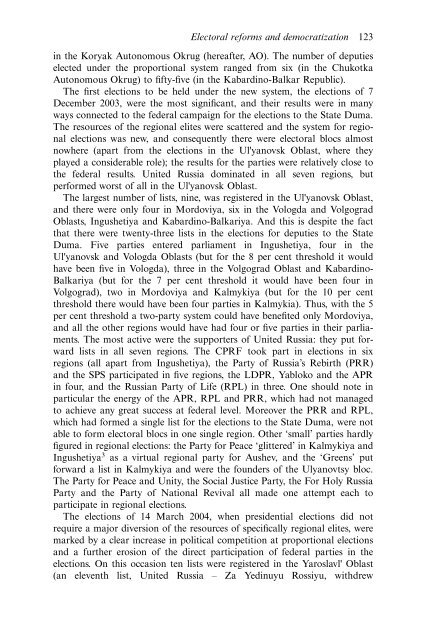Federalism and Local Politics in Russia
Federalism and Local Politics in Russia
Federalism and Local Politics in Russia
You also want an ePaper? Increase the reach of your titles
YUMPU automatically turns print PDFs into web optimized ePapers that Google loves.
Electoral reforms <strong>and</strong> democratization 123<strong>in</strong> the Koryak Autonomous Okrug (hereafter, AO). The number of deputieselected under the proportional system ranged from six (<strong>in</strong> the ChukotkaAutonomous Okrug) to fifty-five (<strong>in</strong> the Kabard<strong>in</strong>o-Balkar Republic).The first elections to be held under the new system, the elections of 7December 2003, were the most significant, <strong>and</strong> their results were <strong>in</strong> manyways connected to the federal campaign for the elections to the State Duma.The resources of the regional elites were scattered <strong>and</strong> the system for regionalelections was new, <strong>and</strong> consequently there were electoral blocs almostnowhere (apart from the elections <strong>in</strong> the Ul'yanovsk Oblast, where theyplayed a considerable role); the results for the parties were relatively close tothe federal results. United <strong>Russia</strong> dom<strong>in</strong>ated <strong>in</strong> all seven regions, butperformed worst of all <strong>in</strong> the Ul'yanovsk Oblast.The largest number of lists, n<strong>in</strong>e, was registered <strong>in</strong> the Ul'yanovsk Oblast,<strong>and</strong> there were only four <strong>in</strong> Mordoviya, six <strong>in</strong> the Vologda <strong>and</strong> VolgogradOblasts, Ingushetiya <strong>and</strong> Kabard<strong>in</strong>o-Balkariya. And this is despite the factthat there were twenty-three lists <strong>in</strong> the elections for deputies to the StateDuma. Five parties entered parliament <strong>in</strong> Ingushetiya, four <strong>in</strong> theUl'yanovsk <strong>and</strong> Vologda Oblasts (but for the 8 per cent threshold it wouldhave been five <strong>in</strong> Vologda), three <strong>in</strong> the Volgograd Oblast <strong>and</strong> Kabard<strong>in</strong>o-Balkariya (but for the 7 per cent threshold it would have been four <strong>in</strong>Volgograd), two <strong>in</strong> Mordoviya <strong>and</strong> Kalmykiya (but for the 10 per centthreshold there would have been four parties <strong>in</strong> Kalmykia). Thus, with the 5per cent threshold a two-party system could have benefited only Mordoviya,<strong>and</strong> all the other regions would have had four or five parties <strong>in</strong> their parliaments.The most active were the supporters of United <strong>Russia</strong>: they put forwardlists <strong>in</strong> all seven regions. The CPRF took part <strong>in</strong> elections <strong>in</strong> sixregions (all apart from Ingushetiya), the Party of <strong>Russia</strong>’s Rebirth (PRR)<strong>and</strong> the SPS participated <strong>in</strong> five regions, the LDPR, Yabloko <strong>and</strong> the APR<strong>in</strong> four, <strong>and</strong> the <strong>Russia</strong>n Party of Life (RPL) <strong>in</strong> three. One should note <strong>in</strong>particular the energy of the APR, RPL <strong>and</strong> PRR, which had not managedto achieve any great success at federal level. Moreover the PRR <strong>and</strong> RPL,which had formed a s<strong>in</strong>gle list for the elections to the State Duma, were notable to form electoral blocs <strong>in</strong> one s<strong>in</strong>gle region. Other ‘small’ parties hardlyfigured <strong>in</strong> regional elections: the Party for Peace ‘glittered’ <strong>in</strong> Kalmykiya <strong>and</strong>Ingushetiya 3 as a virtual regional party for Aushev, <strong>and</strong> the ‘Greens’ putforward a list <strong>in</strong> Kalmykiya <strong>and</strong> were the founders of the Ulyanovtsy bloc.The Party for Peace <strong>and</strong> Unity, the Social Justice Party, the For Holy <strong>Russia</strong>Party <strong>and</strong> the Party of National Revival all made one attempt each toparticipate <strong>in</strong> regional elections.The elections of 14 March 2004, when presidential elections did notrequire a major diversion of the resources of specifically regional elites, weremarked by a clear <strong>in</strong>crease <strong>in</strong> political competition at proportional elections<strong>and</strong> a further erosion of the direct participation of federal parties <strong>in</strong> theelections. On this occasion ten lists were registered <strong>in</strong> the Yaroslavl' Oblast(an eleventh list, United <strong>Russia</strong> – Za Yed<strong>in</strong>uyu Rossiyu, withdrew
















